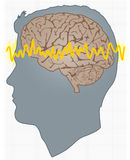|
Thought Authentication
I recently considered thought authentication as a possible and somewhat futuristic mechanism for identity validation using thought vibrations. As I wrote my last article about identity validation using personal and unique information that a) we know such as a pass code, or b) we possess such as an ID card, or c) we are such as our finger print, I started thinking about thought vibrations as a way to validate our identities in order to access systems and places or make payments. I know that the biometric authentication is not widely used yet or even confirmed as the next generation of an authentication mechanism, but what if our thoughts can be considered a possible authentication mechanism that should be further researched and considered for secure access. Although the mind authentication concept is very new, I can not deny its possibility and remain open minded to its use in the future. Researchers in quantum physics have studied the affects of thought vibrations for some time which have been used and tested in some cases. Our thoughts have unique vibrations which can be used to validate our identities for accessing many systems and places. It’s kind of like the parking garage remote door openers which send special signals to the receiver inside the garage and open the door. This concept similar to the light waves which we use to cook our food was unthinkable just a few years ago but they are some of the most fascinating inventions which still place me in a state of awe once in a while. Based on a few articles I have read about this subject lately, identities can be validated by using thought vibration or signals. There are some applications which are capable of extracting specific information or signals from a person’s thoughts. If these brain signals can be somewhat organized and properly used for thought authentication purposes with the improved version of some existing software, such thought authentication can provide a strong mechanism for validating identities. In addition, such strong authentication mechanism will also be resistant to unauthorized access using shoulder surfing, token or body part takeover although I’m not sure about the effect of forced thoughts such as when someone is kidnapped and forced to think his way into a system or building. The possibility of using thought waves for authentication purposes should not be taken lightly as there are currently some systems which can recognize such brain activity patterns. We could not even conceive such idea of using a person’s finger prints or eyes for authenticating the person just a short while back, although these authentication mechanisms are currently being used in the world. Return to the workplace information protection section from "thought authentication". |